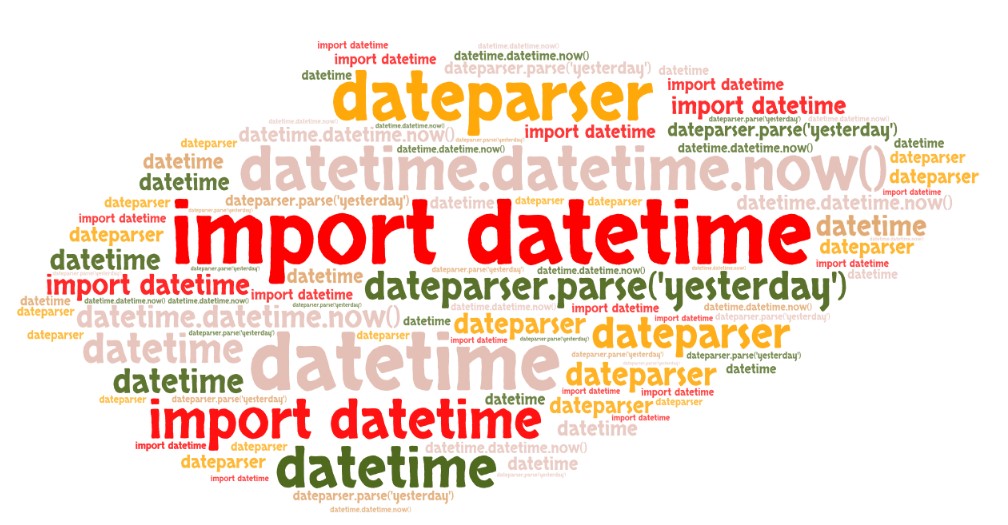Python date and time
Table of contents:
- Meet datetime
- Convert string to datetime
- Convert datetime to string
- Using the
dateparserlibrary - Strftime
Working with date and time in python is important, and it should be fun and easy, but if you know how.
Meet datetime
Example:
import datetime
dt = datetime.datetime.now()
print(dt)
Output:
2020-01-27 18:42:21.070687
What’s inside the datetime object dt?
Properties like year, month, day, …
| property | value |
|---|---|
| year | 2020 |
| month | 1 |
| day | 27 |
| hour | 18 |
| minute | 58 |
| second | 44 |
| microsecond | 800037 |
| tzinfo | None |
Further general properties:
| property | value |
|---|---|
| min | 0001-01-01 00:00:00 |
| max | 9999-12-31 23:59:59.999999 |
| resolution | 0:00:00.000001 |
| fold | 0 |
Important methods:
| method | description |
|---|---|
| astimezone | convert to local time in new timezone. |
| ctime | return ctime() style string. |
| date | return date object with same year, month and day. |
| dst | return self.tzinfo.dst(self) |
| fromisoformat | datetime from datetime.isoformat() output |
| fromordinal | date corresponding to a proleptic Gregorian ordinal. |
| fromtimestamp | local time from POSIX timestamp. |
| isocalendar | return a 3-tuple containing ISO year, week number, and weekday. |
| isoformat | string in ISO 8601 format |
| isoweekday | return the day of the week represented by the date. |
| now | returns new datetime object representing current time local to tz. |
| replace | return datetime with new specified fields. |
| strftime | format style string. |
| strptime | new datetime parsed from a string |
| time | return time object with same time but with tzinfo=None. |
| timestamp | return POSIX timestamp as float. |
| timetuple | return time tuple, compatible with time.localtime(). |
| timetz | return time object with same time and tzinfo. |
| today | current date or datetime |
| toordinal | return proleptic Gregorian ordinal. January 1 of year 1 is day 1. |
| tzname | return self.tzinfo.tzname(self). |
| utcfromtimestamp | construct a naive UTC datetime from a POSIX timestamp. |
| utcnow | return a new datetime representing UTC day and time. |
| utcoffset | return self.tzinfo.utcoffset(self). |
| utctimetuple | return UTC time tuple |
| weekday | return the day of the week represented by the date. |
Create datetime from year, month, date …
Example:
import datetime
dt = datetime.datetime(2020, 1, 27, 7, 6, 5)
print(dt) # 2020-01-27 07:06:05
Create datetime from timestamp
Example:
import datetime
timestamp = 1580099322
dt = datetime.datetime.fromtimestamp(timestamp)
print(dt) # 2020-01-27 05:28:42
Getting date and time from datetime
Call the methods date() and time() to get date and time part respectively.
Example:
import datetime
dt = datetime.datetime.now()
d = dt.date()
t = dt.time()
print(d) # 2020-01-27
print(t) # 21:22:26.005131
print(t.strftime("%H:%M:%S")) # 21:22:26
Combine date and time to datetime
This would be an easy showcase to combine date and time parts to datetime format.
Example:
import datetime
d = datetime.datetime.now().date()
t = datetime.datetime.now().time()
dt = datetime.datetime.combine(d,t)
print(dt)
Convert string to datetime
This conversion assumes we use strptime function where we take the existing string and apply formating to get the datetime object.
Example:
str = '01/27/2020 17:55:26'
dt = datetime.datetime.strptime(str, '%m/%d/%Y %H:%M:%S')
print(dt) # 2020-01-27 17:55:26
str = '1/27/2020 17:55:26'
dt = datetime.datetime.strptime(str, '%m/%d/%Y %H:%M:%S')
print(dt) # 2020-01-27 17:55:26
str = '1-27-2020 17:55:26'
dt = datetime.datetime.strptime(str, '%m-%d-%Y %H:%M:%S')
print(dt) # 2020-01-27 17:55:26
str = '1-27-20 17:55:26'
dt = datetime.datetime.strptime(str, '%m-%d-%y %H:%M:%S')
print(dt) # 2020-01-27 17:55:26
str = '27 January 2020 17:55:26'
dt = datetime.datetime.strptime(str, '%d %B %Y %H:%M:%S')
print(dt) # 2020-01-27 17:55:26
str = 'Jan 27 20 17:55:26'
dt = datetime.datetime.strptime(str, '%b %d %y %H:%M:%S')
print(dt) # 2020-01-27 17:55:26
Convert datetime to string
This conversion assumes we use strftime function:
Example:
import datetime
dt = datetime.datetime.now()
print(dt) # 2020-01-27 20:36:40.814245
d = dt.strftime('%m/%d/%Y, %H:%M:%S')
print(d) # 01/27/2020, 20:37:31
d = dt.strftime('%d %b, %Y')
print(d) # 27 Jan, 2020
d = dt.strftime('%d %B, %Y')
print(d) # 27 January, 2020
d = dt.strftime('%I%p')
print(d) # 08PM
Using the dateparser library
dateparser is a date parsing library designed to parse dates from HTML pages.
To install:
pip install dateparser
Example:
import dateparser
d = dateparser.parse('yesterday')
print(d) # 2020-01-26 19:01:57.348509
d = dateparser.parse('two days ago')
print(d) # 2020-01-25 19:02:31.545787
d = dateparser.parse('2020 January 27th 00:05:23')
print(d) # 2020-01-27 00:00:00
d = dateparser.parse('2020 27 Jan T00:05:23')
print(d) # 2020-01-27 00:05:23
d = dateparser.parse('2020-01-27 00:05:23.283')
print(d) # 2020-01-27 00:05:23.283000
d = dateparser.parse('2020-01-27 00:05:23.283+00:00')
print(d) # 2020-01-27 00:05:23.283000+00:00
d = dateparser.parse('2020-01-27T00:05:23+04:00')
print(d) # 2020-01-27 00:05:23+04:00
As you can see you can parse dates ending with st, nd, rd, and in general can convert almost any date formated string to a datetime.
Strftime
Check the strftime website for mote details
| Code | Example |
|---|---|
| %a | Mon |
| %A | Monday |
| %w | 0-6 (Sunday-Saturday) |
| %d | 30 (day of the month) |
| %b | Sep |
| %B | September |
| %m | 09 (month) |
| %y | 20 (year) |
| %Y | 2020 |
| %H | 07 (24-hour clock) |
| %I | 07 (12-hour clock) |
| %p | AM |
| %M | 06 (min) |
| %S | 05 (sec) |
| %f | 000000 (microsec) |
| %j | 273 (day of the current year) |
| %U | 39 (week of the current year) |
| %c | Mon Sep 30 07:06:05 2013 |
| %x | 09/30/13 |
| %X | 07:06:05 |

…
tags: date - time - string & category: python
